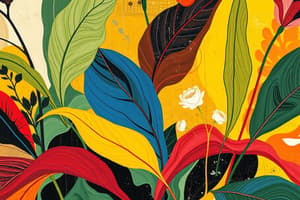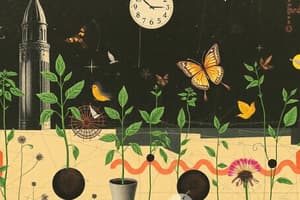Podcast
Questions and Answers
मानवी मेंदूच्या संरक्षणात्मक थरांना काय म्हणतात?
मानवी मेंदूच्या संरक्षणात्मक थरांना काय म्हणतात?
- न्यूरोग्लिया
- व्हेंट्रिकल्स
- सेंट्रल कॅनाल
- मेनिंजेस (correct)
मानवी मेंदूतील व्हेंट्रिकल्स आणि सेंट्रल कॅनालमध्ये रक्ताभिसरण द्रव (cerebro-spinal fluid) नसतो.
मानवी मेंदूतील व्हेंट्रिकल्स आणि सेंट्रल कॅनालमध्ये रक्ताभिसरण द्रव (cerebro-spinal fluid) नसतो.
False (B)
प्रौढ मानवी मेंदूचे वजन साधारणपणे किती असते?
प्रौढ मानवी मेंदूचे वजन साधारणपणे किती असते?
1300-1400 ग्रॅम
पाठीच्या कण्याला ______ संरक्षण देते.
पाठीच्या कण्याला ______ संरक्षण देते.
मानवी मज्जासंस्थेचा (nervous system) मुख्य नियंत्रक भाग कोणता आहे?
मानवी मज्जासंस्थेचा (nervous system) मुख्य नियंत्रक भाग कोणता आहे?
मानवी मेंदूमध्ये फक्त काही हजार न्यूरॉन्स असतात.
मानवी मेंदूमध्ये फक्त काही हजार न्यूरॉन्स असतात.
मेंदूतील पोकळ्यांना (cavities) काय म्हणतात?
मेंदूतील पोकळ्यांना (cavities) काय म्हणतात?
मेंदूच्या भागांना त्यांच्या कार्याशी जुळवा:
मेंदूच्या भागांना त्यांच्या कार्याशी जुळवा:
खालीलपैकी कोणते संप्रेरक (hormone) पिट्युटरी ग्रंथीद्वारे (Pituitary Gland) स्त्रवले जाते?
खालीलपैकी कोणते संप्रेरक (hormone) पिट्युटरी ग्रंथीद्वारे (Pituitary Gland) स्त्रवले जाते?
अधिवृक्क ग्रंथी (Adrenal Glands) थायमोसिन (Thymosine) नावाचे संप्रेरक स्त्रावते.
अधिवृक्क ग्रंथी (Adrenal Glands) थायमोसिन (Thymosine) नावाचे संप्रेरक स्त्रावते.
कसोटी (Testis) द्वारे स्त्रवलेल्या संप्रेरकाचे नाव काय आहे?
कसोटी (Testis) द्वारे स्त्रवलेल्या संप्रेरकाचे नाव काय आहे?
_________ हे संप्रेरक गर्भाशयाला (uterus) बाळंतपणाच्या वेळेस आकुंचन करण्यास मदत करते.
_________ हे संप्रेरक गर्भाशयाला (uterus) बाळंतपणाच्या वेळेस आकुंचन करण्यास मदत करते.
खालील अंतःस्रावी ग्रंथी (endocrine glands) आणि त्यांच्या संप्रेरकांचे (hormones) योग्य जोड्या लावा:
खालील अंतःस्रावी ग्रंथी (endocrine glands) आणि त्यांच्या संप्रेरकांचे (hormones) योग्य जोड्या लावा:
खालीलपैकी कोणते कार्य थायरॉक्झिन (Thyroxine) या संप्रेरकाचे आहे?
खालीलपैकी कोणते कार्य थायरॉक्झिन (Thyroxine) या संप्रेरकाचे आहे?
एड्रेनालाईन (Adrenaline) हे संप्रेरक रक्तातील सोडियम (Na+) आणि पोटॅशियम (K+) चे संतुलन राखते.
एड्रेनालाईन (Adrenaline) हे संप्रेरक रक्तातील सोडियम (Na+) आणि पोटॅशियम (K+) चे संतुलन राखते.
थाइमस (Thymus) ग्रंथीद्वारे स्त्रावलेल्या संप्रेरकाचे नाव काय आहे?
थाइमस (Thymus) ग्रंथीद्वारे स्त्रावलेल्या संप्रेरकाचे नाव काय आहे?
(chemical co-ordination) ?
(chemical co-ordination) ?
(excretion) (system) .
(excretion) (system) .
(Prolactin) ?
(Prolactin) ?
(Testosterone)__________________, ____.
(Testosterone)__________________, ____.
(hormones) :
(hormones) :
(excretory system) (organ) ?
(excretory system) (organ) ?
(Phototropism) (response) .
(Phototropism) (response) .
Flashcards
वाढ हार्मोन (Growth Hormone)
वाढ हार्मोन (Growth Hormone)
हाडांच्या विकासाला उत्तेजित करतो.
अॅड्रीनोकॉर्टिकोट्रॉपिक हार्मोन
अॅड्रीनोकॉर्टिकोट्रॉपिक हार्मोन
अॅड्रेनल ग्रंथीला उत्तेजित करतो.
थायरॉइड उत्तेजक हार्मोन
थायरॉइड उत्तेजक हार्मोन
थायरॉइड ग्रंथीला उत्तेजित करतो.
प्रोलॅक्टिन
प्रोलॅक्टिन
Signup and view all the flashcards
फॉलिकूल उत्तेजक हार्मोन
फॉलिकूल उत्तेजक हार्मोन
Signup and view all the flashcards
लुटेनायझिंग हार्मोन
लुटेनायझिंग हार्मोन
Signup and view all the flashcards
ऑक्सिटोसिन
ऑक्सिटोसिन
Signup and view all the flashcards
प्रोजेस्टेरोन
प्रोजेस्टेरोन
Signup and view all the flashcards
आर्द्रता
आर्द्रता
Signup and view all the flashcards
झाइलम
झाइलम
Signup and view all the flashcards
न्युरॉन्स
न्युरॉन्स
Signup and view all the flashcards
न्यूरोग्लिया
न्यूरोग्लिया
Signup and view all the flashcards
मायनिंज
मायनिंज
Signup and view all the flashcards
वेंट्रिकल्स
वेंट्रिकल्स
Signup and view all the flashcards
तणाव क्रिया
तणाव क्रिया
Signup and view all the flashcards
केंद्रिय नर्वस प्रणाली
केंद्रिय नर्वस प्रणाली
Signup and view all the flashcards
हार्मोन
हार्मोन
Signup and view all the flashcards
अंतःस्रावी ग्रंथी
अंतःस्रावी ग्रंथी
Signup and view all the flashcards
ल्यूटिनायझिंग हार्मोन
ल्यूटिनायझिंग हार्मोन
Signup and view all the flashcards
नैसर्गिक वर्ज्यताम्हणजे
नैसर्गिक वर्ज्यताम्हणजे
Signup and view all the flashcards
फोटोट्रॉपिझम
फोटोट्रॉपिझम
Signup and view all the flashcards
प्लांट एक्सक्रेतेशन
प्लांट एक्सक्रेतेशन
Signup and view all the flashcards
किडनी
किडनी
Signup and view all the flashcards
Study Notes
Matching Columns
- A1: Growth of pollen tube towards ovule B1: Chemotropic Movement
- A2: Growth of shoot system B2: Phototropic Movement
- A3: Growth of root system B3: Gravitropic Movement
- A4: Growth towards water B4: Hydrotropic Movement
Completing the Paragraph
- The passage describes a reflex action triggered by burning milk.
- Nerve cells transmit information from dendrites to the cell body and then along the axon.
- The signal crosses synapses, which are tiny spaces between nerve cells, to reach the muscle.
- The action is completed by a nerve to muscle cell action.
Root Pressure Explanation
- (i): Root cells absorb water and minerals from the soil.
- (ii): Water and minerals flow into root cells due to differing concentrations.
- (iii): This absorption creates turgor pressure in the cells.
- (iv): This pressure pushes water and minerals towards the xylem.
- (v): Continuously pushing water and minerals upwards creates a water column.
- (vi): This pressure moves water to shrubs, small plants, and trees.
Transpiration
- Plants release water vapour from stomata on their leaves.
- Guard cells regulate the opening and closing of stomata.
- Water evaporates, reducing water level in the epidermal leaf layer.
- Water is drawn upwards from the xylem to replenish lost water.
- Transpiration aids in water and mineral absorption.
- Root pressure helps push water during night.
Nerve Cell
- Neurons transmit impulses throughout the body.
- Neurons are the structural and functional components of the nervous system.
- Neurons can be several meters in length.
- Nerve cells transmit electrochemical impulses.
- Neuroglial cells support and function to nerve cells.
Human Brain
- The brain is the main control center of the nervous system.
- The brain is protected within the cranial cavity.
- Meninges are protective layers surrounding the brain and spinal cord.
- Ventricles are cavities within the brain.
- The central canal is a cavity in the spinal cord.
- Cerebrospinal fluid fills ventricles and spaces between meninges, nourishing and protecting.
Reflex Action
- A reflex action is an involuntary immediate response to a stimulus.
- It happens without conscious thought.
- Responses are triggered by certain stimuli in the surroundings.
Endocrine Glands and Hormones
- The table lists glands, their hormones, and functions.
- Hormones are chemical messengers that regulate various body processes.
Nephron
- A nephron is the functional unit of the kidney.
- It comprises Bowman's capsule, proximal convoluted tubule, loop of Henle, and distal convoluted tubule.
- Blood in the nephron filters to remove unwanted substances.
- Some substances are reabsorbed, maintaining balance.
Nervous system
- Dendrite transmit signal to axon.
- Node of Ranvier gaps inbetween cells along the axon.
- Axon carries impulse or signal.
- Myelinated structure ensures faster impulses.
Human Excretory System
- The excretory system removes wastes like urea, ammonia, and uric acid from the body.
- Kidneys, ureters, bladder, and urethra are the key players.
Plant Excretion
- Plants don't have specialized excretion organs.
- Waste products are released when the plant sheds or excretes.
- Plant excretion products, like oxygen, CO2, or tannin, have numerous applications.
Plant Coordination
- Plants use tropism (growth responding to a stimulus) to coordinate movement.
- Examples include phototropism (light), gravitropism (gravity), chemotropism (chemicals), hydrotropism (water), and thigmotropism (touch).
- Plant hormones often influence these movements.
###Co-ordination
- Multicellular organisms depend on coordination between different organ systems to function properly.
- Co-ordination ensures that various bodily functions (temperature regulation, enzyme levels etc.) occur in the right sequence.
- It involves maintaining a state of equilibrium, called homeostasis.
Human Excretion
- The excretory system removes waste and maintains fluid balance.
- Kidneys filter waste products from the blood, forming urine.
- Urine travels through ureters to the bladder and is eliminated through the urethra.
Root Pressure and Transpiration
- Root Pressure: Water and minerals move upwards due to water absorbed by roots, creating turgor pressure.
- Transpiration: Water evaporates from leaves via stomata, pulling water up through xylem vessels.
Studying That Suits You
Use AI to generate personalized quizzes and flashcards to suit your learning preferences.



